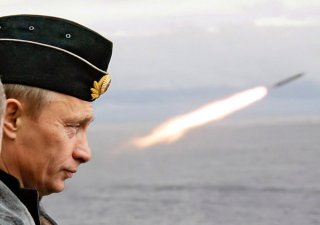Dead Hand: Russia's Scary Plan to Counter Attack After a U.S. Nuclear First Strike
A very mad version of MAD.
The 1970s were some of the lowest years of Cold War for the United States. In that decade, the Vietnam War divided the American public who, dazed and confused from the long, grinding war cried for peace at any price. The Soviet Union was leading the nuclear arms race and appeared strong.
But then the Reagan Administration entered office with a bold, if risky plan for winning the Cold War. In Regan’s America, the United States would not purchase its security through surrender—the American retreat was over and accommodation had no place in the United States’ foreign policy.
This policy shift was intended to convince the Soviet Union that the United States was not afraid of nuclear war by expressing a willingness to strike the USSR, and it worked. Reagan’s rhetoric, and real or proposed military advancements like the Star Wars plan—a space-based system of weapons that could shoot down Soviet missiles—seriously worried Soviet leadership. If the United States struck the USSR first and had the ability to shoot down Soviet retaliatory missiles then the U.S. could not only initiate a nuclear war, but also survive it.
Soviet officials believed that the United States would not back off fighting a nuclear war—and maybe even was confident enough to start one. The Soviet Union felt they were backed up against a wall. So they built Dead Hand.
Dead Hand
Dead Hand was a fail-safe (or rather, fail-deadly) system of launching whatever Russian nuclear intercontinental ballistic missiles survived the aftermath of an American first strike. A Wired article described the system’s abilities:
“It was designed to lie semi-dormant until switched on by a high official in a crisis. Then it would begin monitoring a network of seismic, radiation, and air pressure sensors for signs of nuclear explosions.” If the information Dead Hand collected indicated a nuclear strike against the Soviet Union may have occurred, it would initiate a verification procedure.
“Before launching any retaliatory strike, the system had to check off four if/then propositions: If it was turned on, then it would try to determine that a nuclear weapon had hit Soviet soil. If it seemed that one had, the system would check to see if any communication links to the war room of the Soviet General Staff remained. If they did, and if some amount of time—likely ranging from 15 minutes to an hour—passed without further indications of attack, the machine would assume officials were still living who could order the counterattack and shut down. But if the line to the General Staff went dead, then Perimeter would infer that apocalypse had arrived.”
Once this nightmare scenario had been established, command missiles stored in hardened, nuclear-blast resistant silos would be launched all over the Soviet Union, transmitting launch sequences to whatever missiles had survived, and authorizing whoever happened to be in the silos to initiate launch and bring about nuclear armageddon.
Even if the Soviet Union’s top military commanders, politicians, leaders, cities, and capital—you name it—were smoldering piles of ash, the Soviet Union could guarantee a retaliation.
Active
There is widespread disagreement over just how autonomous Dead Hand actually was. There is also disagreement over Dead Hand’s existence today, though Russian officials have confirmed that Dead Hand did exist in the past, and that a similar fail-deadly system is still in existence. Though the Soviet-era Dead Hand does not play the outsized role in Russian nuclear strategy that it used to, here’s to hoping it is not on such a sensitive hair-trigger as during the Cold War.
Caleb Larson holds a Master of Public Policy degree from the Willy Brandt School of PublicPolicy. He lives in Berlin and writes on U.S. and Russian foreign and defense policy, German politics, and culture.
Image: Reuters

